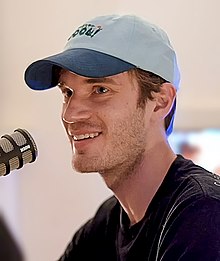YouTuber
A YouTuber, also known as a YouTube content creator, is a type of videographer or entertainer who produces videos for the video-sharing website YouTube, sometimes being supported by networks. Some YouTube personalities also have corporate sponsors who pay for product placement in their clips or production of online videos. These content-creators are often referred as "influencers".
Etymology
The name "YouTuber" refers to individual(s) whose main or only platform are YouTube channel(s), personalized subpages of the YouTube video sharing platform.[1]
History

The Internet domain name "www.youtube.com" was activated on February 14, 2005 by Chad Hurley, Steve Chen, and Jawed Karim, when they worked for PayPal.[2] The first YouTube channel "Jawed" was created on April 23, 2005 PDT (April 24, 2005 UTC) by the YouTube co-founder of the same name.[3][4] He uploaded the first YouTube video, a short vlog clip titled Me at the zoo, on the same day.[5]
In October 2005, YouTube introduced the ability to subscribe to YouTube channels.[6] The New York Times claims that most YouTube videos up until 2006 were focused on different forms of talent, citing back-flip stunts, lip-syncing, and other people's talents being uploaded via clips such as clips of Saturday Night Live.[7] By June 2006, recognized Hollywood and music industry firms had begun to establish formal business ties with "homegrown" YouTube talent—the first believed to be comedian blogger Brooke "Brookers" Brodack (through Carson Daly),[8] then singer Justin Bieber (through Usher),[9] and physician-become-political satirist Bassem Youssef (through an Egyptian television network).[10][11] In 2007 YouTube started its "Partner Program", an ad-revenue-sharing arrangement that allowed for YouTubers to make money off the videos they uploaded to YouTube.[12]
By October 2015, there were more than 17,000 YouTube channels with more than 100,000 subscribers, and nearly 1,500 with more than a million.[13] These numbers have grown to almost 44,000 channels with at least 250,000 subscribers in January 2019.[14]
Influence

According to multiple studies, YouTubers have become an important source of information and entertainment for the millennial and Generation Z-generations. Influential YouTubers are frequently described as microcelebrities.[1] Since YouTube is widely conceived as a bottom-up social media video platform, microcelebrities do not appear to be involved with the established and commercial system of celebrity culture but rather appear self-governed and independent. This appearance, in turn, leads to YouTubers being seen as more relatable and authentic, also fostered by the direct connection between artist and viewer using the medium of YouTube.[13][1]
These microcelebrities often communicate with their viewers which gives a more friendly outlook. The content- creators of YouTube (YouTubers) create content on a wide range of variety including vlogs, instructive, how to, informative videos, and more.
In a 2014 survey conducted by the University of Southern California among 13-18 year-olds in the United States on whether 10 YouTube celebrities or 10 traditional celebrities were more influential, YouTube personalities took the first five spots of the ranking, with Smosh ranking as most influential.[13] When repeated in 2015, the survey found six YouTubers on the first ranks, with KSI ranked as most influential.[13][15]
Several prominent YouTubers and their influence were subjects for scientific studies, such as Zoella[1] and PewDiePie.[16] Because of this level of influence, Robert Hovden argued for the creation of a new index similar to the g-index and h-index to evaluate a person's output and impact on YouTube.[17]
Commercial success
YouTubers can earn revenue off of Google AdSense. Additionally, they can supplement their income through affiliate links, merchandising, and 3rd party memberships such as ones on Patreon.[18] Popular channels have garnered corporate sponsors, who pay to be included in the videos.[18] In 2018, Walmart, Nordstrom, and others sought YouTube stars as influencers.[19]
In 2015, NME stated that "vlogging has become big business."[20] In 2015, Forbes reported that Felix Kjellberg, known on YouTube as PewDiePie, had earned $12 million in 2014, more than some popular actors such as Cameron Diaz or Gwyneth Paltrow.[21] Additionally, YouTube stars have crossed over to other media platforms including late-night television such as Canadian Youtuber Lilly Singh, who hosts the talk show A Little Late with Lilly Singh on NBC.[22]
See also
References
- Jerslev, Anne (2016-10-14). "In the Time of the Microcelebrity: Celebriyiiii7ification the YouTuber Zoella". International Journal of Communication. 10 (2016): 5233–5251. ISSN 1932-8036.
- Graham, Jefferson (November 21, 2005). "Video websites pop up, invite postings". USA Today. Retrieved May 2, 2018.
- "jawed". YouTube. Retrieved 2018-06-02.
- "Extract Meta Data". citizenevidence.amnestyusa.org. Retrieved 2018-06-02.
- "YouTube created a FOMO viewing culture over the past 13 years". Polygon. April 23, 2018.
- "Official YouTube Blog". Retrieved 2018-06-10.
- Carney, John (2006-04-16). "People Who Watch People: Lost in an Online Hall of Mirrors". The New York Times. ISSN 0362-4331. Retrieved 2018-06-03.
- Collins, Scott (June 19, 2006). "Now she has their attention". Los Angeles Times. Archived from the original on January 16, 2014.
- Herrera, Monica (March 19, 2010). "Justin Bieber - The Billboard Cover Story". Billboard. Archived from the original on January 16, 2014. Retrieved June 6, 2018.
- Simon, Bob (March 16, 2014). "Meet the "Jon Stewart of Egypt": Bassem Youssef (60 Minutes transcript)". CBS News. Archived from the original on March 17, 2014. Retrieved June 7, 2018.
- "Youssef: 'Important to have other opinions'". Deutsche Welle. February 7, 2014. Archived from the original on March 17, 2014. Retrieved June 7, 2018.
- John Seabrook (January 16, 2012). "Streaming Dreams". www.newyorker.com. Archived from the original on 9 January 2014. Retrieved 2018-06-06.
- Dredge, Stuart (2016-02-03). "Why are YouTube stars so popular?". The Guardian. Retrieved 2018-05-03.
- Patrick van Kessel (December 4, 2019). "10 facts about Americans and YouTube". Pew Research Center. Retrieved December 17, 2019.
- Ault, Susanne (2015-07-23). "Digital Star Popularity Grows Versus Mainstream Celebrities". Variety. Retrieved 2018-05-03.
- Beers Fägersten, Kristy (2017-08-01). "The role of swearing in creating an online persona: The case of YouTuber PewDiePie". Discourse, Context & Media. 18: 1–10. doi:10.1016/j.dcm.2017.04.002. ISSN 2211-6958.
- Hovden, Robert (2013-09-12). "Bibliometrics for Internet media: Applying theh-index to YouTube". Journal of the American Society for Information Science and Technology. 64 (11): 2326–2331. arXiv:1303.0766. doi:10.1002/asi.22936. ISSN 1532-2882.
- "Evan Edinger: The five ways YouTubers make money". BBC Newsbeat. 2017-12-18. Retrieved 2020-07-10.
- Jones, Charisse (6 August 2018). "Walmart, Nordstrom and others look to YouTube stars to woo millennials and Gen Z". CNBC. NBCUniversal. Retrieved 7 August 2018.
- Bassett, Jordan (13 August 2015). "NME Investigation: Are YouTubers The New Pop Stars?". NME. Retrieved 28 January 2020.
- Mandle, Chris (15 October 2015). "Forbes names PewDiePie as highest-earning YouTuber with annual income reaching $12m". The Independent. Retrieved 11 June 2018.
- Leskin, Paige. "The life and rise of Lilly Singh, the YouTube star who now hosts her own late night show and is now worth over $10 million". Business Insider. Retrieved 13 April 2020.